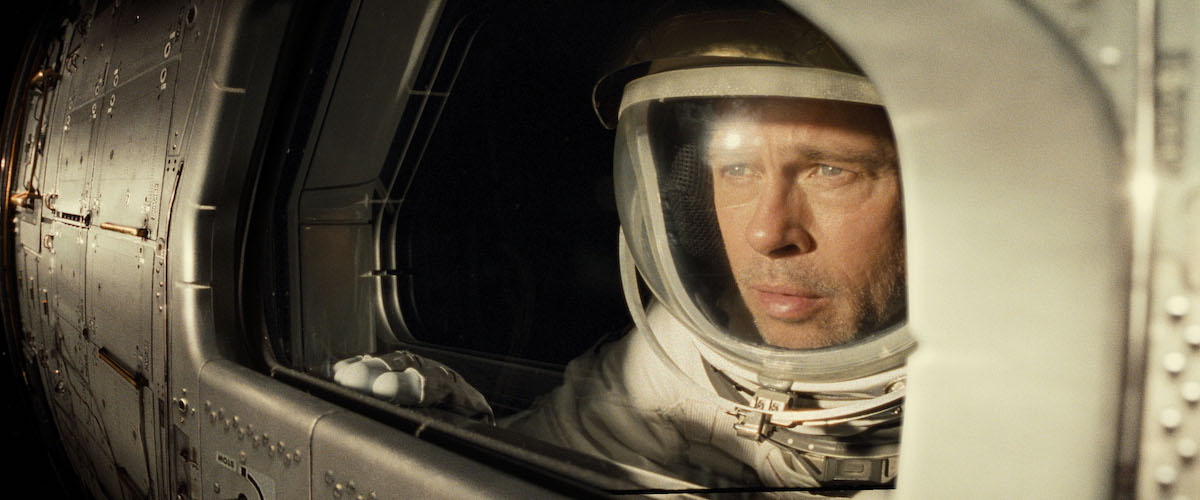We’re decades into the era where Star Wars and Star Trek have set the default visual language for movies about space, but much more recently there’s been a gratifying trend of movies centred around much more realistic depictions of space like Gravity and Interstellar, created in part to stand apart from the more Hollywood versions of life and travel in space, and this movie looked in the trailers like another example that was beautifully designed and shot.

Fortunately it was. From the globestopping opening as astronaut Roy McBride (Brad Pitt) falls back toward Earth after an apparent attack on a vast antenna array that stretches from Earth into space, director James Gray wants us to believe this is really happening on our planet in the near future, where the incredible technology and processes have evolved from what we know about spaceflight today. There were scenes and individual shots where I got the feeling Gray and his collaborators wanted to make something like 2001: A Space Odyssey for a new generation.
And they may well have done so, because like that film the emotional delivery of Ad Astra leaves you incredibly cold and uninvolved no matter how interesting the plot is (and it only kind-of is).
The chain of explosions aboard the spacebound antenna that send McBride tumbling back to Earth, Felix Baumgarter-style, are the result of pulses of energy that have travelled across the solar system to wreak havoc on Earth. After he recovers, the brass tell him in secret that the pulses are originating aboard a craft Roy’s astronaut dad Clifford (Tommy Lee Jones) manned 26 years earlier in order to search for extraterrestrial life and which disappeared from contact. It seems, they tell him, that Clifford is still there and seems intent on destroying life on Earth, and that they think contact from Roy is the only thing that will make him see reason.
But they can’t get a decent bead on his location from Earth so he has to send the message from a Mars base. First stop is the moon, where he takes a commercial flight alongside one of Clifford’s former associates (Donald Sutherland). They’re met by a military escort whose job is to ferry them through dangerous territory run by pirates across the surface to a base on the far side, which is where Roy will try to raise his Dad. He adheres to a schedule of attempts, but when there’s no result he’s ordered back to Earth.

But the Mars station manager Helen (Ruth Negga) tells him the truth, showing him video footage proving that the project’s staff wanted to return to Earth, but that Clifford wouldn’t let them leave and killed them all when they tried to resist him. The crew that bought Roy to the Moon – which is going on to try and find Clifford’s ship – isn’t actually going to try and contact Roy but destroy his ship. With only one chance to save his father Roy stows away aboard the rocket, the fight that ensues when he’s discovered leaving him the only one left alive.
He goes slightly mad on the weeks-long trip out to the orbit of Neptune, where Clifford’s craft is lying silently just off the ring system. It’s not a big surprise that his father’s still aboard and still alive, but writers Gray and Ethan Gross are so hell bent on being all enigmatic and profound that for all Clifford’s ravings, you still have no real idea of his motivation. Much as I could gather it was because he’d lost faith in humanity and decided to destroy it, or that his data had proven that humans are indeed alone in the universe and it had driven him insane with despair. Maybe it’s a bit of both, maybe neither.
The scenery and visual effects are amazing, even in an era where we’ve had Gravity, Interstellar and their many homages. But the problem is that the whole thing is so unengaging it will leave you as cold as the space it depicts. Roy’s wife (Liv Tyler) walks out on him in an early scene because of his refusal to open himself up after losing his father years before, and every time Pitt’s on screen you’ll understand why. Add to that this well-worn characterisation of the emotionally closed off and stoic hero and he’s the blandest thing on screen. It’s such a common trope in screenwriting in fact we’ve not only seen it recently but we’ve seen it in another recent astronaut movie (First Man).
The stop-offs on the moon and Mars and one of the ships on which Roy travels going off its original path to answer a distress call are very well made set pieces, they just don’t add up to much narratively. The lunar rover battle in particular isn’t just a great action scene, it shows some great world-building, establishing a history of cultural development on the moon while giving us a car chase the likes of which we’ve never seen.
All in all Gray, Pitt and co are trying too hard to have their cake (looking, moving and feeling like a lavishly designed modern successor to 2001) and eat it too (mass appeal), but there’s just not enough in the middle of the Venn diagram between them.
Subscribe to FIB’s Weekly Alchemy Report for your weekly dose of music, fashion and pop culture news!







